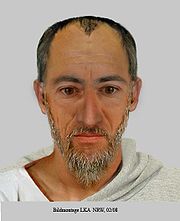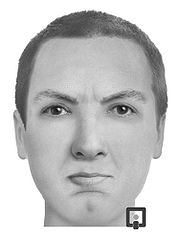
Facial composite
Encyclopedia


Witness
A witness is someone who has firsthand knowledge about an event, or in the criminal justice systems usually a crime, through his or her senses and can help certify important considerations about the crime or event. A witness who has seen the event first hand is known as an eyewitness...
's memory of a face, as recorded by a composite artist. Facial composites are used mainly by police in their investigation of (usually serious) crimes.
PhotoFIT generation
Construction of the composite was originally performed by a trained artist, through drawing, sketching, or painting, in consultation with a witness or crime victim. In the 1960s techniques were devised for use by those less artistically skilled, employing interchangeable templates of separate facial features, such as "Photofit" in the UK and Smith & WessonSmith & Wesson
Smith & Wesson is the largest manufacturer of handguns in the United States. The corporate headquarters is in Springfield, Massachusetts. Founded in 1852, Smith & Wesson's pistols and revolvers have become standard issue to police and armed forces throughout the world...
's "Identi-Kit" in the US.
In the last two decades, a number of computer based facial composite systems have been introduced, amongst the most widely used systems are "Identi-Kit 2000", FACES, and E-FIT. In the U.S. the FBI
Federal Bureau of Investigation
The Federal Bureau of Investigation is an agency of the United States Department of Justice that serves as both a federal criminal investigative body and an internal intelligence agency . The FBI has investigative jurisdiction over violations of more than 200 categories of federal crime...
maintains that hand-drawing is its preferred method for constructing a facial composite. Many other police agencies, however, use software, since suitable artistic talent is often not available.
Evolutionary systems
Until quite recently, the facial composite systems used by international police forces were exclusively based on a construction methodology in which individual facial features (eyes, nose, mouth, eyebrows, etc.) are selected one at a time from a large database and then electronically ’overlaid’ to make the composite image. Such systems are often referred to as feature-based since they essentially rely on the selection of individual features in isolation. However, after a long period of research and development work conducted largely within British Universities, systems based on a rather different principle are finding increasing use by police forces. These systems may be broadly described as holistic or global in that they primarily attempt to create a likeness to the suspect through an evolutionary mechanism in which a witness’s response to groups of complete faces (not just features) converges towards an increasingly accurate image. Three such systems have come from academic beginnings, EFIT-V from the University of Kent, EvoFIT from Stirling and Central Lancashire University, and ID from the University of Cape Town, South Africa.Research
A general review of research into the evaluation of mechanical template techniques may be found in Davies and Valetine (2006) A review of research into more modern 'feature' and 'recognition' systems, and into methods for improving the effectiveness of composites, may be found in Frowd et al. (2008) and (2009).The systems used in the UK have been subjected to a number of academic studies. These have typically shown that E-FIT and PRO-fit produce composites that are correctly named, either immediately or a few hours after construction, about 20% of the time (see Brace et al. (2000), Bruce et al. (2002), Davies et al. (2000) and Frowd et al. (2005)). When witnesses in these studies are required to wait two days before constructing a composite, which matches real use more closely, naming falls to a few percent at best (e.g. Frowd et al. (2005) and (2007)). The reason for the low level of naming from these systems appears to be that witnesses are unable to accurately construct the internal features of the face after long delays, the region that is important for recognition by another person later (Frowd et al. (2007)).
Evolutionary systems show a marked improvement in accuracy. In academic trials, research on a fairly-recent version of the EvoFIT system has shown correct naming levels of about 25% after a 2-day delay(see Frowd et al. (2010)) -- using more-recent techniques, the performance of EvoFIT has now approximately doubled to 45% correct naming (Frowd et al. (in press)). Similarly in extensive field use EFIT-V has shown a 40% naming rate over an 18 month period with 1000 interviews. The EvoFIT system has been similarly evaluated in formal police field-trials. These evaluations have reported a much higher naming rate for EvoFIT composites but, using the latest interview techniques, an arrest rate of nearly 40%. A recent case whereby an EvoFIT directly led to the arrest of a serial rapist may be found at http://www.dailymail.co.uk/news/article-2019031/Evo-fit-New-facial-identification-technology-helps-catch-rapist-Asim-Javed.html. Accompanying the development of EvoFIT has been new approaches in the type of interview administered to eyewitnesses prior to face construction (e.g. Frowd et al. (2008)).
Usage
While the classic use of the facial composite is the citizen recognizing the face as an acquaintance, there are other ways where a facial composite can prove useful. The facial composite can contribute in law enforcement in a number of ways:- Identifying the suspect in a wanted posterWanted posterA wanted poster is a poster distributed to let the public know of an alleged criminal whom authorities wish to apprehend. They will generally include either a picture of the alleged criminal when a photograph is available, or of a facial composite image produced by a police artist...
. - Additional evidence against a suspect.
- Assisting investigation in checking leads.
- Warning vulnerable population against serial offenders.
Facial composites of various types have been used extensively in those television programmes which aim to reconstruct major unsolved crimes with a view to gaining information from the members of the public, such as "America's Most Wanted
America's Most Wanted
America's Most Wanted is an American television program produced by 20th Television, and was the longest-running program of any kind in the history of the Fox Television Network until it was announced on May 16, 2011 that the series was canceled after twenty-three years, with the final episode...
" in the US and "Crimewatch
Crimewatch
Crimewatch is a long-running and high-profile British television programme produced by the BBC, that reconstructs major unsolved crimes with a view to gaining information from the members of the public. The programme is usually broadcast once a month on BBC One...
" in the UK.
Notable cases
Some important criminal cases where facial composites have assisted in identifying the perpetrator:- The Oklahoma Bomber Timothy McVeighTimothy McVeighTimothy James McVeigh was a United States Army veteran and security guard who detonated a truck bomb in front of the Alfred P. Murrah Building in Oklahoma City on April 19, 1995...
. - HagamannenHagamannenKurt Niklas Lindgren , known in the media prior to his arrest as Hagamannen , is a convicted Swedish serial rapist. Lindgren was convicted of nine counts of sexual assault in 2006, two of which were labeled attempted murder, in relation to attacks in the city of Umeå from 1998 to 2005...
, a serial sexual assaulter in SwedenSwedenSweden , officially the Kingdom of Sweden , is a Nordic country on the Scandinavian Peninsula in Northern Europe. Sweden borders with Norway and Finland and is connected to Denmark by a bridge-tunnel across the Öresund....
. - The Baton Rouge Serial Killer Derrick Todd LeeDerrick Todd LeeDerrick Todd Lee is a convicted serial killer, nicknamed the Baton Rouge Serial Killer....
. - Manchester serial rapist

